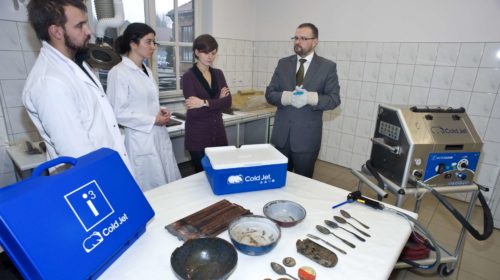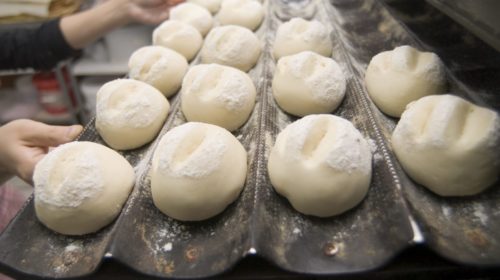
General Mills cuts costs and equipment downtime while increasing productivity by 80%
THE SITUATION
The General Mills Bakeries and Foodservice Plant in Chanhassen, Minnesota is a leading producer of baked and unbaked food products. The facility produces a variety of goods, including flour mixes, doughs, bread, cake and cereal. After the goods are baked and ready for packaging, they are transported through cooling tunnels, which maintain the quality of the products while they are being transferred to the packaging area. With the high production levels of the plant, grease, oil, dust and flour quickly begin to accumulate on the conveyors, motors and panels in the cooling tunnels. The facility had been cleaning the tunnels with steam, water, and in some areas, by hand.
Conditions in commercial bakeries, and food and beverage facilities in general, are closely monitored by regulatory bodies. There are many laws that dictate cleanliness levels and cleaning operations. Regulations govern where, if at all, chemical cleaning products are able to be used. The use of water in the cleaning process also poses regulatory and sanitation issues. Water is difficult to collect and recycle, thus leaving moisture, which can result in biological growth.
Given the highly regulated nature of food facilities, the cleaning method and process must be carefully considered by each plant.
THE PROBLEM
The Chanhassen plant’s cleaning process was slow, inefficient and ineffective. The cleaning methods did not fully remove the grease, flour and other contaminants from the various surfaces of the tunnels. Machines within the cooling tunnels had to be shut down while a team of three workers cleaned the tunnels and collected the resulting waste water.
Their cleaning process was very labor intensive and required workers to manually scrub some surfaces, such as the electric motors, with chemical solvents. The process also proved to be ineffective with small parts and hard to reach areas not being fully cleaned. The cleaning methods also led to recurring breakage of parts and machines due to corrosion caused by the use of water, harsh chemicals and rigorous scrubbing or scraping. In the event of a breakage, the line had to be shut down and productivity was lost. Overall, the cleaning process required a total of 7.5 to 9 man hours to complete. The result was that the tunnel was 80% clean, at best.
THE SOLUTION
Following the advice of several General Mills sister locations, the Chanhassen plant contacted Cold Jet and requested a demonstration of dry ice cleaning on their cooling tunnels and in other areas of their facility. The testing proved successful with the dry ice blasting process removing 90-100% of the build-up from the tooling and machines. The staff was impressed that the process restored the machines to their original conditions. They calculated that dry ice blasting cleaned the machines in 1/3 of the time of the previous process.
Cold Jet’s dry ice cleaning system uses non-abrasive media in the form of recycled CO2 pellets that do not damage surfaces or equipment. The combination of dry ice cleaning’s kinetic energy and thermal effect breaks the connection between the contaminant and surface, lifting them away. Unlike blasting with other media, dry ice cleaning does not leave any secondary waste, because the dry ice particles sublimate upon impact – converting from solid to gas. Dry ice cleaning is safe and non-toxic, does not create downstream contamination and reduces or eliminates employee exposure to dangerous chemical cleaning agents.
Dry ice is a food grade media that is EPA, FDA and USDA approved for use around food manufacturing. It is colorless, tasteless, odorless and non-toxic. It allows for the elimination of environmentally harmful cleaning chemicals and eliminates worker exposure to hazardous cleaning agents. It also does not produce any toxic waste that must be disposed of.
THE RESULTS
Using Cold Jet’s Aero Series, the Chanhassen plant cut equipment downtime in half and reduced sanitation labor from two to three workers to just one. The facility cut cleaning setup time 50% by eliminating the need to cover and uncover adjacent, water-sensitive machinery such as electrical motors. Overall, the plant increased productivity by 80% due to more efficient labor allocation and a reduction in downtime associated with cleaning.
The plant was also able to cut costs associated with water usage and disposal, labor and time costs and costs associated with line shutdown. The plant also reduced the costs of replacing machinery broken by the previous abrasive and harmful cleaning methods. The facility estimated that they gained an 80% improvement in equipment life by eliminating water and chemicals.
Initial testing was carried out on the cooling tunnels because they were the plant’s hardest machines to clean and knew that if dry ice blasting could effectively clean these tunnels, then the process could be applied in the cleaning of the rest of their bakery equipment.
The plant also cleaned other equipment, such as proof boxes, dough dividers, baggers, conveyors, slicers, ovens and electrical cabinets that supplied power to the entire plant.
In addition to achieving consistent sanitation standards and gains in efficiency, the plant also improved the safety and working conditions of their employees. Due to the fact that manually scrubbing with solvents was eliminated, workers were no longer exposed to harmful chemicals or the sharp edges of machines. The possibility of slipping on wet floors was also removed by omitting water from the cleaning process.

